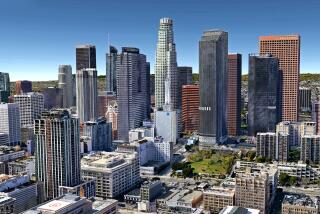Headquarters for Oak Sold; Cost Not Told
Buie Corp., a San Diego-based residential and commercial developer, has agreed to buy Oak Industries’ lavish headquarters building in Rancho Bernardo for an undisclosed sum, the companies said Monday.
Sources close to the deal say Buie will pay “in the vicinity of $9 million” for the 78,000-square-foot, Spanish Colonial-style building. Escrow is expected to close February. Oak refused Monday to disclose what it cost to build the structure in 1979, the year before the firm moved its headquarters there from Crystal Lake, Ill.
Remodeling Scheduled
Chairman Bob Buie said the building will be remodeled into a multitenant office building suitable for tenants seeking 3,000 to 5,000 square feet of space. He added that the remodeling will not violate the “architectural integrity” of the structure, which resembles a richly appointed Spanish hacienda.
Oak was asking $15 million for the building when it was for sale in 1985. But Oak trimmed the asking price to below $10 million in recent months. When Coldwell Banker first listed the building in March, 1985, a sales brochure indicated that the building could “functionally be divided to accommodate up to eight tenants.”
Oak, an electronics components manufacturer, decided to sell the building after financial problems resulted in Oak’s corporate staff being cut to about 40 people from 225. The building has been slow to sell, sources said, because of Oak’s high asking price and Rancho Bernardo’s overbuilt office market.
According to David Sharp, director of research at C.W. Clark Inc., the office vacancy rate in the so-called Interstate 15 corridor, which includes Rancho Bernardo, was 25.2% earlier this month, making it one of the softest submarkets in San Diego County. As recently as last December, the area’s vacancy rate was 33%, he said.
Sore Point With Some
The building, which features a tiled inner courtyard and a well-tended garden, has been a sore point to many Oak shareholders, who complained that former Oak Chairman Everitt A. Carter wasted corporate assets on the project.
The disclosure that Carter’s wife, Brenda Mason, was paid $1 million for interior decoration at the headquarters and at an overseas plant also generated controversy.
Carter, who resigned in 1984, later became the key figure in a complex web of civil lawsuits lodged by disgruntled shareholders and the Securities & Exchange Commission. Carter later signed a consent agreement prohibiting him from ever again serving as an officer or director of a U.S.-based company.
The SEC alleged in its complaint that Carter and other former Oak executives defrauded shareholders through misrepresentation in public financial disclosures.
$300 Million in Losses
From 1981 through 1985, Oak accumulated $300 million in losses and, at one point in 1985, had a negative $69.9 million net worth. By early 1985, Oak had decided to sell the building as part of its “strategy to reduce under-utilized assets.”
The building might have been under-utilized by Oak in recent years, but real estate professionals still describe it as an exceptional property. For example, the office now occupied by E.L. McNeely, Oak’s chairman since 1984, features open-beam ceilings, teak parquet floors and a tiled hearth. The executive board room features wrought iron chandeliers and beautifully carved doors.
The building’s private offices and central secretarial pools are decorated with teak doors, ceramic tile baseboards and metal chandeliers. A large, well-decorated auditorium, 14 bathrooms and six kitchens are located elsewhere in the building
Buie is a San Diego-based residential and commercial developer and builder with projects in San Diego, Orange and Riverside counties.
Oak has not determined where it will move when the deal is completed early next year, spokeswoman Mary Lou Coburn said.
More to Read
Inside the business of entertainment
The Wide Shot brings you news, analysis and insights on everything from streaming wars to production — and what it all means for the future.
You may occasionally receive promotional content from the Los Angeles Times.









